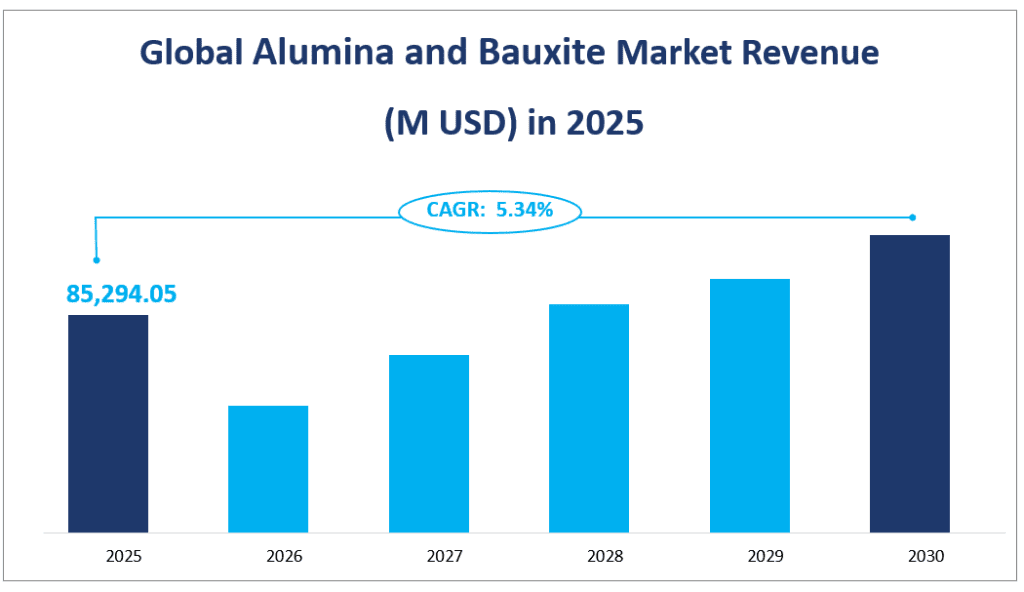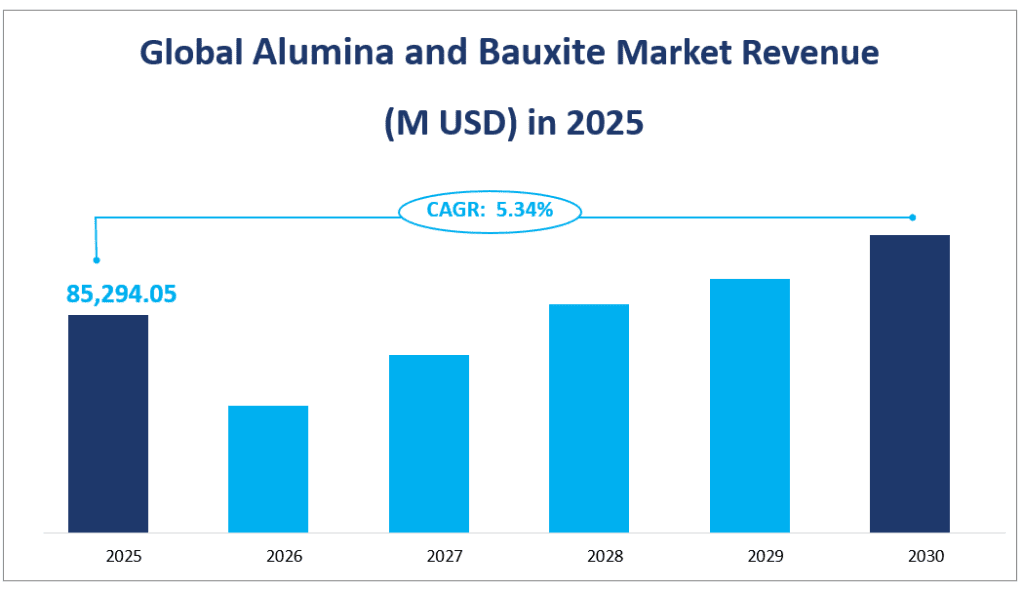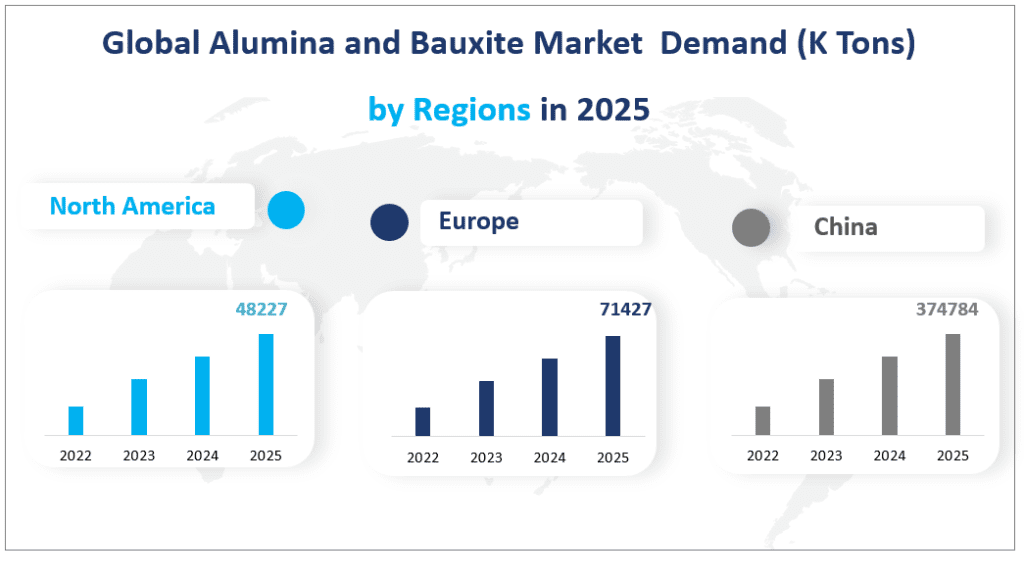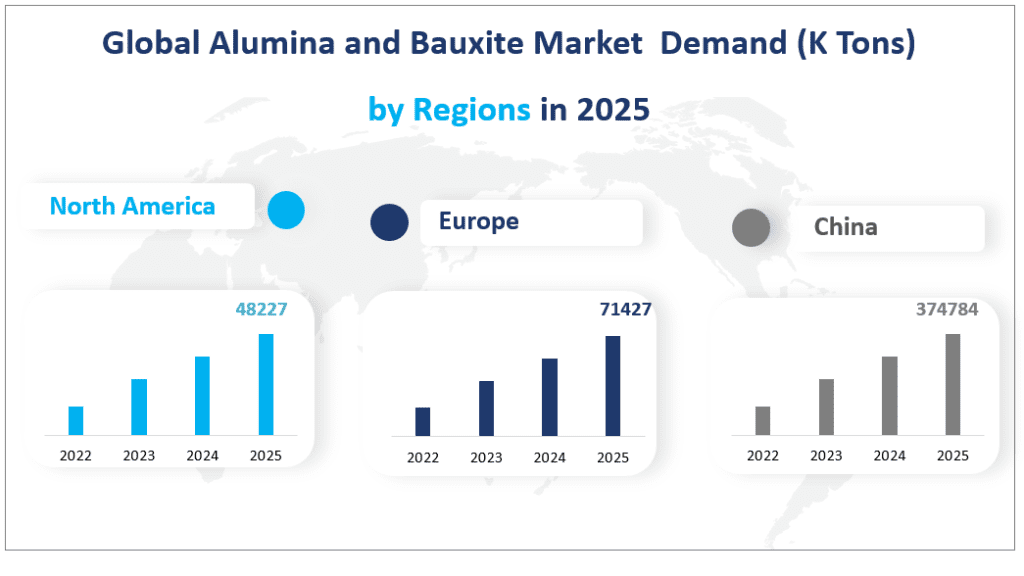1. Global Alumina and Bauxite Market Revenue and CAGR Forecast
In 2025, the global alumina and bauxite market is projected to generate a revenue of $85,294.05 million with a CAGR of 5.34% from 2025 to 2030. Alumina, or aluminum oxide (Al₂O₃), is a white powdery substance derived from bauxite through a refining process known as the Bayer process. It is a critical material in the production of aluminum, which is the second most used metal globally after steel. Bauxite, on the other hand, is a sedimentary rock rich in aluminum hydroxide minerals such as gibbsite, boehmite, and diaspore. It is the primary source of alumina and, by extension, aluminum.
The significance of alumina and bauxite extends beyond the aluminum industry. Alumina is also used in the production of refractory materials, ceramics, and abrasives due to its high melting point, hardness, and corrosion resistance. Additionally, it is utilized in the chemical industry as a catalyst and in the production of various aluminum compounds. Bauxite, while primarily processed for alumina, also has applications in the production of cement and as a flux in steelmaking.
Global Alumina and Bauxite Market Revenue (M USD) in 2025


2. Driving Factors of Alumina and Bauxite Market
The most significant of these is the increasing demand for aluminum, which is a lightweight, durable, and versatile metal. Aluminum is widely used in the automotive industry to reduce vehicle weight and improve fuel efficiency, in construction for window frames and structural components, and in the aerospace industry for aircraft components. The growing global economy and increasing urbanization, especially in emerging economies like China and India, are driving the demand for aluminum products, thereby boosting the alumina and bauxite market.
Another driving factor is the continuous innovation in manufacturing technologies. The development of more efficient refining and smelting processes has led to increased production capacities and lower costs. This technological progress has made alumina and bauxite more accessible and affordable, further stimulating market growth.
3. Limiting Factors of Alumina and Bauxite Market
Despite the positive outlook, the alumina and bauxite market faces several challenges that could limit its growth. One of the primary concerns is the environmental impact of bauxite mining and alumina refining. These processes can lead to deforestation, soil erosion, and water pollution, raising environmental concerns and regulatory scrutiny. Governments worldwide are implementing stricter environmental regulations to mitigate these impacts, which can increase operational costs for producers.
Another limiting factor is the geographical distribution of bauxite resources. Major bauxite reserves are concentrated in a few regions, such as Guinea, Australia, and Brazil. This concentration can lead to supply chain vulnerabilities, as geopolitical issues or natural disasters in these regions can disrupt the global supply of bauxite and alumina. For example, the recent coup in Guinea raised concerns about the stability of bauxite supplies from the country.
Additionally, the market is highly competitive, with a few large players dominating the industry. These companies have significant market power, which can make it difficult for new entrants to establish themselves. The high capital requirements for setting up bauxite mines and alumina refineries also act as a barrier to entry.
4. Global Alumina and Bauxite Market Segment
Product Types
In 2025, the market revenue for Non-Metallurgical Products is projected to reach $7,342.23 million. This category includes products such as refractories, abrasives, high alumina cement, aluminum chemicals, and active bauxite. These products are essential in various industries, including ceramics, construction, and chemical manufacturing. Despite their importance, Non-Metallurgical Products hold a relatively smaller market share compared to Metallurgical Products.
On the other hand, Metallurgical Products dominate the market with a projected revenue of $77,951.81 million in 2025. These products are primarily used in the aluminum industry to extract metallic aluminum. The demand for Metallurgical Products is driven by the increasing need for aluminum in sectors such as automotive, aerospace, and construction.
Metallurgical Products hold the largest market share. This dominance is attributed to the critical role of alumina in the production of aluminum, which is a fundamental material in modern industrial applications.
Analysis of Alumina and Bauxite Market Applications
In 2025, the market revenue for Electrolytic Aluminum is projected to be $77,770.71 million. This application is the largest consumer of alumina and bauxite, driven by the growing demand for aluminum in the automotive, aerospace, and construction industries. Electrolytic Aluminum accounts for the majority of the market share due to its extensive use in producing lightweight and durable aluminum products.
The Ceramic Industry is another significant application area, with a projected revenue of $2,657.43 million in 2025. Alumina ceramics are widely used in high-temperature applications, such as refractory materials, due to their excellent thermal and mechanical properties. Although the market share of the Ceramic Industry is smaller compared to Electrolytic Aluminum, it is still a crucial segment, especially in the manufacturing of advanced ceramics and electronic components.
The Chemical Industry also plays a vital role, with a projected revenue of $2,632.19 million in 2025. Alumina is used as a catalyst and in the production of various aluminum compounds, contributing to the growth of this application segment. The demand for alumina in the Chemical Industry is driven by the need for high-purity materials in chemical synthesis and processing.
Electrolytic Aluminum holds the largest market share in 2025. This dominance is due to the extensive use of aluminum in various industrial applications, making it the primary driver of alumina and bauxite demand.
The global alumina and bauxite market is characterized by diverse product types and applications, each contributing uniquely to the overall market dynamics. Metallurgical Products dominate the market in terms of revenue and growth rate, driven by the increasing demand for aluminum. Similarly, Electrolytic Aluminum is the largest application segment, with the Ceramic Industry showing the fastest growth rate. Understanding these market segments is crucial for stakeholders to capitalize on growth opportunities and address potential challenges in the alumina and bauxite industry.
Market Revenue by Segment
| Market Revenue (M USD) in 2025 | ||
| By Type | Non-Metallurgical Products | 7342.23 |
| Metallurgical Products | 77951.81 | |
| By Application | Electrolytic aluminum | 77770.71 |
| Ceramic industry | 2657.43 | |
| Chemical industry | 2632.19 | |
| Others | 2233.72 |
5. Regional Alumina and Bauxite Market
China is projected to remain the largest regional market for alumina and bauxite in 2025, with a demand of 374784 K Tons. This significant demand is driven by China’s robust industrial base, particularly in the production of aluminum and its downstream applications. China’s aluminum industry is one of the largest in the world, and its demand for alumina and bauxite is expected to continue growing as the country advances its industrialization and urbanization efforts.
Europe is the second-largest regional market for alumina and bauxite, with a projected demand of 71427 K Tons in 2025. Europe’s demand is driven by its established automotive, aerospace, and construction industries, which rely heavily on aluminum for lightweight and durable components. The region’s focus on sustainability and high-quality manufacturing standards also supports the demand for alumina and bauxite.
The Middle East and Africa region is projected to have a demand of 48227 K Tons in 2025. This region’s demand for alumina and bauxite is driven by increasing industrialization and infrastructure development, particularly in countries like Saudi Arabia, the United Arab Emirates, and South Africa.
The region’s rich natural resources, particularly in bauxite, and its strategic location make it an important player in the global alumina and bauxite market. Additionally, the region’s focus on diversifying its economies and reducing reliance on oil exports is expected to drive further growth in the demand for alumina and bauxite.
Global Alumina and Bauxite Market Demand (K Tons) by Regions in 2025


6. Top 3 Companies in the Global Alumina and Bauxite Market
Company Introduction and Business Overview
Alcoa Corporation is a global industry leader in bauxite, alumina, and aluminum products. Established in 1888, Alcoa has a strong portfolio of value-added cast and rolled products and substantial energy assets. The company operates worldwide, with a significant presence in North America, Europe, Asia, and Australia. Alcoa is known for its innovative and sustainable practices, focusing on reducing carbon emissions and improving operational efficiency.
Products Offered
Alcoa offers a wide range of products, including smelting-grade alumina for aluminum manufacturers and non-metallurgical-grade alumina for industrial chemistry businesses. The company also produces aluminum ingots, rolled products, and value-added products for various industries, such as automotive, aerospace, and packaging.
In 2023, Alcoa Corporation reported a sales revenue of $6,747.98 million.
Company Introduction and Business Overview
Rio Tinto Alcan is a global leader in aluminum production, with significant operations in bauxite mining, alumina refining, and aluminum smelting. Established in 1873, the company has a strong presence in Canada, Australia, and other regions. Rio Tinto Alcan is known for its technologically advanced smelters, which use clean hydropower to produce high-quality aluminum with a low carbon footprint.
Products Offered
Rio Tinto Alcan offers a variety of products, including high-purity alumina, smelting-grade alumina, and aluminum ingots. The company also produces specialty aluminum products for the automotive, aerospace, and consumer goods industries. Rio Tinto Alcan’s focus on sustainability and innovation has helped it maintain a competitive edge in the market.
In 2023, Rio Tinto Alcan reported a sales revenue of $5,876.81 million.
Company Introduction and Business Overview
United Company RUSAL is a leading global aluminum producer, with operations in 20 countries across five continents. Established in the 1880s, RUSAL is known for its low-carbon aluminum production and innovative technologies. The company employs over 62,000 people worldwide and is committed to reducing greenhouse gas emissions through the use of renewable energy and energy-saving technologies.
Products Offered
RUSAL offers a wide range of products, including metallurgical-grade alumina, non-metallurgical-grade alumina, and aluminum ingots. The company also produces specialty products such as aluminum hydroxide and alumina trihydrate for various industrial applications. RUSAL’s focus on sustainable production has helped it gain a significant market share in the global alumina and bauxite industry.
In 2023, United Company RUSAL reported a sales revenue of $2,925.46 million.
Major Players
| Company Name | Headquarters | Market Distribution |
| Alcoa Corporation | USA | Worldwide |
| Rio Tinto Alcan | Canada | Worldwide |
| United Company RUSAL | Russia | Worldwide |
| Norsk Hydro ASA | Norway | Worldwide |
| CHALCO | China | Worldwide |
| BHP Billiton Group | Australia | Worldwide |
| Hindalco Industries | India | Worldwide |
| National Aluminum | India | Worldwide |
1 Alumina and Bauxite Introduction and Market Overview
1.1 Objectives of the Study
1.2 Overview of Alumina and Bauxite
1.3 Alumina and Bauxite Market Scope and Market Size Estimation
1.3.1 Market Concentration Ratio and Market Maturity Analysis
1.3.2 Global Alumina and Bauxite Revenue and Growth Rate from 2018-2028
1.4 Market Segmentation
1.4.1 Types of Alumina and Bauxite
1.4.2 Applications of Alumina and Bauxite
1.4.3 Research Regions
1.5 Market Dynamics
1.5.1 Alumina and Bauxite Industry Trends
1.5.2 Alumina and Bauxite Drivers
1.5.3 Alumina and Bauxite Market Challenges
1.5.4 Alumina and Bauxite Market Restraints
1.6 Industry News and Policies by Regions
1.6.1 Industry News
1.6.2 Industry Policies
1.7 Mergers & Acquisitions, Expansion Plans
1.8 Alumina and Bauxite Industry Development Trends under COVID-19 Outbreak
1.8.1 Global COVID-19 Status Overview
1.8.2 Influence of COVID-19 Outbreak on Alumina and Bauxite Industry Development
1.9 Impact of Russia and Ukraine War
2 Industry Chain Analysis
2.1 Upstream Raw Material Supply and Demand Analysis
2.1.1 Global Alumina and Bauxite Major Upstream Raw Material and Suppliers
2.1.2 Raw Material Source Analysis
2.2 Major Players of Alumina and Bauxite
2.2.1 Major Players Headquarters of Alumina and Bauxite in 2022
2.2.2 Major Players Market Distribution in 2022
2.3 Alumina and Bauxite Manufacturing Cost Structure Analysis
2.3.1 Production Process Analysis
2.3.2 Manufacturing Cost Structure of Alumina and Bauxite
2.3.3 Labor Cost of Alumina and Bauxite
2.4 Market Channel Analysis of Alumina and Bauxite
2.5 Major Down Stream Customers of Bauxite
3 Global Alumina and Bauxite Market, by Type
3.1 Global Alumina and Bauxite Revenue and Market Share by Type (2018-2023)
3.2 Global Alumina and Bauxite Supply and Market Share by Type (2018-2023)
3.3 Global Alumina and Bauxite Revenue and Growth Rate by Type (2018-2023)
3.3.1 Global Alumina and Bauxite Revenue and Growth Rate of Non-Metallurgical Products
3.3.2 Global Alumina and Bauxite Revenue and Growth Rate of Metallurgical Products
3.4 Global Alumina and Bauxite Price Analysis by Type (2018-2023)
3.4.1 Explanation of Different Type Product Price Trends
4 Alumina and Bauxite Market, by Application
4.1 Downstream Market Overview
4.2 Global Alumina and Bauxite Demand and Market Share by Application (2018-2023)
4.3 Global Alumina and Bauxite Consumption and Growth Rate by Application (2018-2023)
4.3.1 Global Alumina and Bauxite Consumption and Growth Rate of Electrolytic aluminum (2018-2023)
4.3.2 Global Alumina and Bauxite Consumption and Growth Rate of Ceramic industry (2018-2023)
4.3.3 Global Alumina and Bauxite Consumption and Growth Rate of Chemical industry (2018-2023)
5 Global Alumina and Bauxite Demand, Revenue (M USD) by Region (2018-2023)
5.1 Global Alumina and Bauxite Revenue and Market Share by Region (2018-2023)
5.2 Global Alumina and Bauxite Demand and Market Share by Region (2018-2023)
5.3 Global Alumina and Bauxite Demand, Revenue, Price and Gross Margin (2018-2023)
5.4 North America Alumina and Bauxite Demand, Revenue, Price and Gross Margin (2018-2023)
5.4.1 North America Alumina and Bauxite Market Under COVID-19
5.4.2 North America Alumina and Bauxite SWOT Analysis
5.5 Europe Alumina and Bauxite Demand, Revenue, Price and Gross Margin (2018-2023)
5.5.1 Europe Alumina and Bauxite Market Under COVID-19
5.5.2 Europe Alumina and Bauxite SWOT Analysis
5.6 China Alumina and Bauxite Demand, Revenue, Price and Gross Margin (2018-2023)
5.6.1 China Alumina and Bauxite Market Under COVID-19
5.6.2 China Alumina and Bauxite SWOT Analysis
5.7 Middle East and Africa Alumina and Bauxite Demand, Revenue, Price and Gross Margin (2018-2023)
5.7.1 Middle East and Africa Alumina and Bauxite Market Under COVID-19
5.7.2 Middle East and Africa Alumina and Bauxite SWOT Analysis
5.8 India Alumina and Bauxite Demand, Revenue, Price and Gross Margin (2018-2023)
5.8.1 India Alumina and Bauxite Market Under COVID-19
5.8.2 India Alumina and Bauxite SWOT Analysis
5.9 South America Alumina and Bauxite Demand, Revenue, Price and Gross Margin (2018-2023)
5.9.1 South America Alumina and Bauxite Market Under COVID-19
5.9.2 South America Alumina and Bauxite SWOT Analysis
5.10 Southeast Asia Alumina and Bauxite Demand, Revenue, Price and Gross Margin (2018-2023)
5.10.1 Southeast Asia Alumina and Bauxite Market Under COVID-19
5.10.2 Southeast Asia Alumina and Bauxite SWOT Analysis
6 Global Alumina and Bauxite Supply by Top Regions (2018-2023)
6.1 Global Alumina and Bauxite Supply by Top Regions (2018-2023)
6.2 China Alumina and Bauxite Supply and Growth Rate
6.3 Australia Alumina and Bauxite Supply and Growth Rate
6.4 Guinea Alumina and Bauxite Supply and Growth Rate
6.5 India Alumina and Bauxite Supply and Growth Rate
7 Global Alumina and Bauxite Demand by Regions (2018-2023)
7.1 Global Alumina and Bauxite Demand by Regions (2018-2023)
7.2 North America Alumina and Bauxite Demand and Growth Rate
7.3 Europe Alumina and Bauxite Demand and Growth Rate
7.4 China Alumina and Bauxite Demand and Growth Rate
7.5 Middle East & Africa Alumina and Bauxite Demand and Growth Rate
7.6 India Alumina and Bauxite Demand and Growth Rate
7.7 South America Alumina and Bauxite Demand and Growth Rate
7.8 Southeast Asia Alumina and Bauxite Demand and Growth Rate
8 Competitive Landscape
8.1 Competitive Profile
8.2 Alcoa Corporation
8.2.1 Company Profiles
8.2.2 Alumina and Bauxite Product Profiles, Application and Specification
8.2.3 Alcoa Corporation Sales, Revenue, Price, Gross Margin 2018-2023
8.2.4 Company Recent Development
8.3 Rio Tinto Alcan Corporation
8.3.1 Company Profiles
8.3.2 Alumina and Bauxite Product Profiles, Application and Specification
8.3.3 Rio Tinto Alcan Corporation Sales, Revenue, Price, Gross Margin 2018-2023
8.3.4 Company Recent Development
8.4 United Company RUSAL Corporation
8.4.1 Company Profiles
8.4.2 Alumina and Bauxite Product Profiles, Application and Specification
8.4.3 United Company RUSAL Corporation Sales, Revenue, Price, Gross Margin 2018-2023
8.4.4 Company Recent Development
8.5 Norsk Hydro ASA Corporation
8.5.1 Company Profiles
8.5.2 Alumina and Bauxite Product Profiles, Application and Specification
8.5.3 Norsk Hydro ASA Corporation Sales, Revenue, Price, Gross Margin 2018-2023
8.5.4 Company Recent Development
8.6 CHALCO Corporation
8.6.1 Company Profiles
8.6.2 Alumina and Bauxite Product Profiles, Application and Specification
8.6.3 CHALCO Corporation Sales, Revenue, Price, Gross Margin 2018-2023
8.7 BHP Billiton Group Corporation
8.7.1 Company Profiles
8.7.2 Alumina and Bauxite Product Profiles, Application and Specification
8.7.3 BHP Billiton Group Corporation Sales, Revenue, Price, Gross Margin 2018-2023
8.7.4 Company Recent Development
8.8 Hindalco Industries Corporation
8.8.1 Company Profiles
8.8.2 Alumina and Bauxite Product Profiles, Application and Specification
8.8.3 Hindalco Industries Corporation Sales, Revenue, Price, Gross Margin 2018-2023
8.8.4 Company Recent Development
8.9 National Aluminum Corporation
8.9.1 Company Profiles
8.9.2 Alumina and Bauxite Product Profiles, Application and Specification
8.9.3 National Aluminum Corporation Sales, Revenue, Price, Gross Margin 2018-2023
9 Global Alumina and Bauxite Market Analysis and Forecast by Type and Application
9.1 Global Alumina and Bauxite Market Revenue & Volume Forecast, by Type (2023-2028)
9.1.1 Non-Metallurgical Products Market Revenue and Volume Forecast (2023-2028)
9.1.2 Metallurgical Products Market Revenue and Volume Forecast (2023-2028)
9.2 Global Alumina and Bauxite Market Revenue & Volume Forecast, by Application (2023-2028)
9.2.1 Electrolytic aluminum Market Revenue Forecast (2023-2028)
9.2.2 Ceramic industry Market Revenue Forecast (2023-2028)
9.2.3 Chemical industry Market Revenue Forecast (2023-2028)
10 Alumina and Bauxite Market Demand Forecast by Region
10.1 North America Market Demand Forecast (2023-2028)
10.2 Europe Market Demand Forecast (2023-2028)
10.3 China Market Demand Forecast (2023-2028)
10.4 Middle East and Africa Market Demand Forecast (2023-2028)
10.5 India Market Demand Forecast (2023-2028)
10.6 South America Market Demand Forecast (2023-2028)
10.7 Southeast Asia Market Demand Forecast (2023-2028)
10.8 Explanation of Market Size Trends by Region
10.9 Alumina and Bauxite Market Trends Analysis
11 New Project Feasibility Analysis
11.1 Industry Barriers and New Entrants SWOT Analysis
12 Research Finding and Conclusion and Expert Interview Record
13 Appendix
13.1 Methodology
13.2 Research Data Source
13.2.1 Secondary Data
13.2.2 Primary Data
13.2.3 Market Size Estimation
13.2.4 Legal Disclaimer
